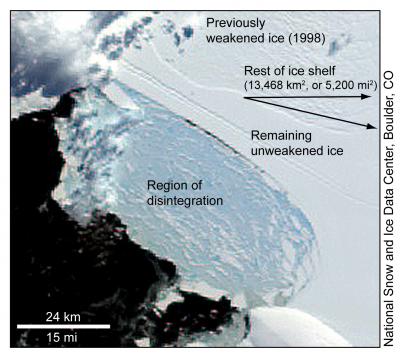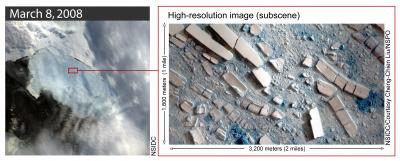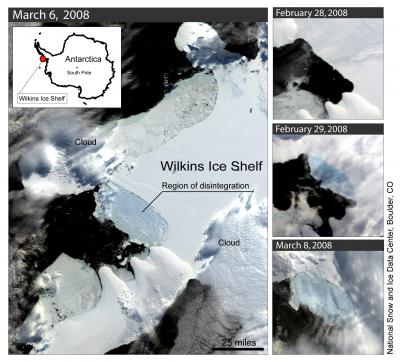Satellite imagery from the National Snow and Ice Data Center at the University of Colorado at Boulder reveals that a 13,680 square kilometer (5,282 square mile) ice shelf has begun to collapse because of rapid climate change in a fast-warming region of Antarctica.
Figure 1. This series of satellite images shows the Wilkins Ice Shelf as it began to break up. The large image is from March 6; the images at right, from top to bottom, are from February 28, February 29, and March 8. NSIDC processed these images from the NASA Moderate Resolution Imaging Spectroradiometer (MODIS) sensor, which flies on NASA's Earth Observing System Aqua and Terra satellites.
The Wilkins Ice Shelf is a broad plate of permanent floating ice on the southwest Antarctic Peninsula, about 1,000 miles south of South America. In the past 50 years, the western Antarctic Peninsula has experienced the biggest temperature increase on Earth, rising by 0.5 degree Celsius (0.9 degree Fahrenheit) per decade. NSIDC Lead Scientist Ted Scambos, who first spotted the disintegration in March, said, “We believe the Wilkins has been in place for at least a few hundred years. But warm air and exposure to ocean waves are causing a break-up.”
Satellite images indicate that the Wilkins began its collapse on February 28; data revealed that a large iceberg, 41 by 2.5 kilometers (25.5 by 1.5 miles), fell away from the ice shelf’s southwestern front, triggering a runaway disintegration of 405 square kilometers (160 square miles) of the shelf interior (Figure 1). The edge of the shelf crumbled into the sky-blue pattern of exposed deep glacial ice that has become characteristic of climate-induced ice shelf break-ups such as the Larsen B in 2002. A narrow beam of intact ice, just 6 kilometers wide (3.7 miles) was protecting the remaining shelf from further breakup as of March 23 (Figure 2).
Scientists track ice shelves and study collapses carefully because some of them hold back glaciers, which if unleashed, can accelerate and raise sea level. Scambos said, “The Wilkins disintegration won’t raise sea level because it already floats in the ocean, and few glaciers flow into it. However, the collapse underscores that the Wilkins region has experienced an intense melt season. Regional sea ice has all but vanished, leaving the ice shelf exposed to the action of waves.”

Figure 2. During the break-up, the Wilkins Ice Shelf broke into a sky-blue pattern of exposed deep glacial ice. This true-color image of the Wilkins Ice Shelf was taken by MODIS on March 6, 2008.
With Antarctica’s summer melt season drawing to a close, scientists do not expect the Wilkins to further disintegrate in the next several months. “This unusual show is over for this season,” Scambos said. “But come January, we’ll be watching to see if the Wilkins continues to fall apart.”
Real-time collaboration images from NASA’s Moderate Resolution Imaging Spectroradiometer (MODIS) and data from ICESat showed that the ice shelf was in a state of collapse in March. Scambos then alerted colleagues around the world, seeking to ensure that every means of gathering information was focused on the break-up.
British Antarctic Survey (BAS) mounted an overflight of the crumbling shelf, collecting video footage and other observations. BAS glaciologist David Vaughan said of the ice shelf, which is supported by a single strip of ice strung between two islands, “Wilkins is the largest ice shelf on West Antarctica yet to be threatened. This shelf is hanging by a thread.”

Figure 3. This image shows a high-resolution, enhanced-color image of the Wilkins Ice Shelf in Antarctica on March 8, 2008. Narrow iceberg blocks (150 meters wide, or 492 feet) crumbled into house-sized rubble. Taiwan's Formosat-2 satellite acquired this image.
The combined efforts of these international teams have begun to provide observational data that will improve scientific understanding of the mechanisms behind ice shelf collapse. Scambos said, “The Wilkins is an example of an event we don’t see very often. But it’s a key process in being able to predict how sea level will change in the future.”
The Wilkins is one of a string of ice shelves that have collapsed in the West Antarctic Peninsula in the past thirty years. The Larsen B became the most well-known of these, disappearing in just over thirty days in 2002. The Prince Gustav Channel, Larsen Inlet, Larsen A, Wordie, Muller, and the Jones Ice Shelf collapses also underscore the unprecedented warming in this region of Antarctica.
This is pretty scary stuff. While this wont raise sea level, it is a canary in the coal mine. This giant sheet of ice is big, but there are much larger ones, and they are warming at a rapid pace. I await with morbid curiosity to see how bad things will have to get before we start to take serious action.

Don’t panic. There has been a substantial net cooling over most of Antarctica over the past half-century, and both winter and summer sea-ice extent have recently been at record levels. All the ice-shelves that have recently disappeared are on the Antarctic Peninsula, which covers only 2% of Antarctica. Studies show that the Larsen B ice shelf was not there during the mediaeval warm period,k and that much of the Wilkins ice shelf is also only a few hundred years old. The total area of the seven ice-shelves that have melted so far is equivalent to only 1/55th of the land area of Texas – and, of course, they contribute not a millimeter to sea-level rise. The Antarctic cooling means net ice-mass averaged across the whole continent has been accumulating (Doran et al., 2002). In Greenland, too, ice-mass has been accumulating, at a rate of 2 inches per year averaged across the whole ice-sheet (Johannesen et al., 2005). Greenland was last ice-free 850,000 years ago, for natural reasons. There are few grounds to blame the tiny changes in Antarctica and Greenland on human activity.
@ Monckton
Good Morning Your “Lordship”:
Oh yeah, I agree, don’t panic. Just get the message. “There are few grounds to blame the tiny changes in Antarctica and Greenland on human activity.” …and CFCs don’t deplete stratospheric ozone, right? We couldn’t possibly have anything to do with this, right? A rise in the global mean temperature does not imply universal warming — warming everywhere on the planet. More like disruption of typical Holocene climate patterns: “climate disruption”.
Doran et al 2002: a bit outdated perhaps? See also: http://www.realclimate.org/index.php/archives/2004/12/antarctic-cooling-global-warming/langswitch_lang/sw
What is happening to the mass balance of Antarctica in spite of recognized cooling in the interior? Did you look at the NASA IceSAT/GLAS data? Or the NASA GRACE data? What about Greenland — are you sure you are right about the mass balance?
I DON’T THINK SO.
I guess the fact that it usually takes, oh, I don’t know hundreds of thousands of years for Greenland to ice up/melt down, doesn’t mean this is unusual? Calving at a glacier terminus is of course natural — but this is something else entirely.
Disrespectfully yours,
anybody who believs the crap that this is due to global warming is stupid, also anybody who blames it on carbon which causes global warming (LOL). Did you know that the truth is that carbon levels follow temperature, not the opposite.Also there has been times with up to 4400 parts of carbon per million unlike the 380 now. So how bout all u scientists quit telling us its bad. And when there was 4400, it was proven to be colder! Also, how does it make u feel when Al Gore (one of the main people supporting global warming/carbon credits) already has a business set up to sell carbon credits which would make him a millionaire, hmmmm. That seems fishy.
Simply: The Earth is going through one of the many cycles that it has always performed – cooling and heating.
I agree with Jeremy about the “follow the money” theory…….is Al Gore going to make money on the environment by stating that we have major issues? Well, if so – would not logic dictate that he would have to create a problem, then solve it? Or market an answer?
Follow the money – people……..
Simply: The Earth is going through one of the many cycles that it has always performed – cooling and heating.
I agree with Jeremy about the “follow the money” theory…….is Al Gore going to make money on the environment by stating that we have major issues? Well, if so – would not logic dictate that he would have to create a problem, then solve it? Or market an answer?
How can we be so smart, yet so dumb?
@Tanya “How can we be so smart, yet so dumb?”
Yes, reading your *double* post I was wondering that exact thing…